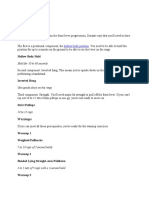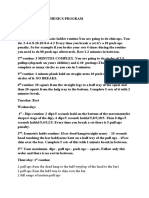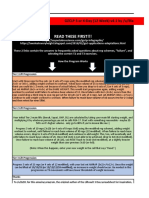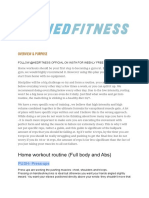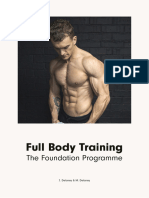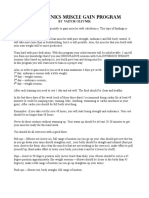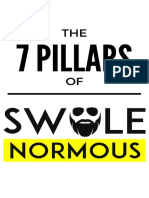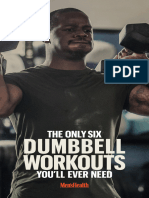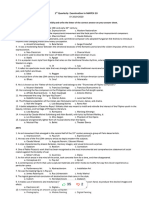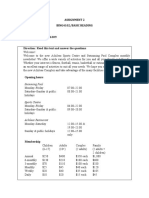Introduction
I want to start this course with explanation why I decided to write it and
where you can use it in term of calisthenics. I’ve seen a lot of basic courses,
but everywhere I’ve seen a bunch of determined exercises. In my course I’ll
explain you how to make up a basic training program for common skills,
regular strength and muscle groups. It’s like a video puzzle and this booklet,
which will help you to collect it based on goal.
There are 3 blocks of videos. First one is pulling strength, second one is
pushing strength and the last one is core strength. All the exercises have 4
levels, so you can get the needed based on your feelings. When you master it,
go to the next level.
Now let’s discuss how to read spreadsheets. As I said, you have 3 blocks
with 7 different groups of exercises and each one has 4 levels.
!2
� So, the first number in a cell means the number of group, the second
(after a dot) means the level of burden. A line in a spreadsheet means one
training. If you see a list (a few) of exercises in one cell, choose an exercise
with needed level of burden. On an outlined picture you can see an example
of spreadsheet line. Usually, one line outlines one training. Based on it, you
can see that in this training there are 3 exercises; in first and third cell you can
choose the needed burden.
Matching level is when you’re able to do at least 80% of reps in the last
set. Sets and reps of each exercise and also the technique of execution are
showed in videos.
WEEKLY PLANING
The most common question I’ve heard from beginners is ‘How often
should I train to progress?’. To be honest, it is impossible to answer it
professionally. The answer will depend on many factors which a coach
should discover while having personal trainings. Nevertheless, I will try to
provide a full answer using different variations in different conditions.
If you are a beginner and you want to build muscles with body weight
training, you should train like a bodybuilder. It’s better to take one muscle
group or motion group (pull or push) and work on it twice a week with full
intensity. That is how you will get maximum efficiency for muscle building.
Use this information in combination with the following programs.
If you are beginner and want to build strength to progress in calisthenics
(I mean dynamic and static skills), but you aren’t ready for practice and
preparing exercises yet, you should use a different approach. Well, first of all
determine a short-term goal. Then, keeping this aim in mind, choose
exercises which you will do really often (5-7 days a week). Usually, they are a
few exercises, maximum 3. That is how you will train neuromuscular system.
Better if these exercises include statics. For example, your short-term goal is
!3
�one arm pull up, so choose pull-ups with upper position hold and do it daily.
Also, don’t train to failure in this case. Otherwise, you won’t have time for
recovery. You should combine this type of training with a full basic training
once a week with full intensity like in previous type of training.
Now let’s discuss how to combine basics with skills when you already
have a good foundation and able to do preparing exercises and practice. I
often face with the question ‘Should I still do basics when I have started skills
training like planche, front lever, handstand, etc.?’ Well, my answer will also
depend on. If your final goal is static tricks, focus on it and exclude basics for
a while - do only practice and preparing exercises for a determined move.
But anyway, with such type of training you have to get back to basics in a
few months to support your basic strength and abilities of muscles. In this
case use Training of Plain Basics outlined below. Or, if you want to work
especially on pulling or pushing, use the matching spreadsheets outlined
below.
If you still want to combine training of aesthetics and skills, you have to
choose one or maximum two moves (I mean static or strength moves) and do
them 3-4 times a week. Don’t train to failure to have enough power for
basics - you should train it twice a week. So, you will have a pretty full
weekly training schedule. Train 6 times a week.
If you want to make your training not that busy, add basic trainings
twice a week in the end of skills training. For sure, these days you have to
decrease the amount of preparing exercises for skills.
As you see, you can diversify your trainings in different ways, and only
your body will be able to advise you which is the best. Play with amount of
exercises and even sets in all the exercises. By my own experience skill
trainings with two sets and maximum reps (or intensity) in combination with
basics in the end of training (two sets and 70% of burden) showed maximum
efficiency.
!4
� REST. PLATEAU
One more common question is ‘How often and how long should I rest?’. My
answer will also be really complex and will depend on a type of training you
chose in the previous chapter.
Well, if you chose the first type and want to work on aesthetics only,
you should rest 1-2 days between trainings.
If you prepare your body for calisthenics, you will rest less but
trainings will not be that full and intensive. As I said, you will have daily
exercises. But of course it doesn’t mean you shouldn’t rest. In this case every
3 weeks you should take 3-4 days of total rest. That is how you relax your
nervous system.
Now let’s consider how you should rest if you choose to train basics
and calisthenics moves simultaneously. If you prefer to separate trainings
and train preparing exercises and basics in different days, you will have only
1-2 rest days which is ok in a short term. But things will change when you
train like that more than a few months. Then you have to choose rest weeks,
when you will do only low intensity work or even total rest.
Plateaus is the most annoying thing in calisthenics. Everyone gets
frustrated when it befalls them. Don’t be sad and keep in mind that everyone
will face that. So, how to deal with plateau? There are many ways how to
come out from this. First one is easy: total rest. But even rest should be smart.
You even shouldn’t think about trainings, because when you imagine
something, your brain repeats it automatically, that is how we learn. So, the
best way to rest is changing your activity for something totally uncommon
for you. In winter I do cross-country skiing, which helps me to switch up a
type of burden.
Other method is stretching, it will help you not only to relax your
nervous system, but also to recover your muscles faster and heal small
injures. I will add basics full body stretching in a next update of basics
course.
!5
� REGULAR STRENGTH
Let’s get started with regular strength. Here you have all the exercises.
Before clicking, let’s get into a plan of training. As I said, you will have
pushing, pulling and core strength. You should train pushing program twice
a week, as well as pulling. About core, you can introduce 3-4 exercises in
pulling workout and pushing. They could be different all the time or the
same which you found the most efficient. Also, you can do core program in a
separate day.
When you get it, your next goal is to determine your current level. In
every exercise and block it could be different. And it is ok. But pay attention
to those blocks and exercises where your level is lower to develop equally.
Let’s suppose you choose to build up basic strength. I will create
examples of trainings for you here. Also, I will explain why I put some
exercises in a training, that will help you to build your own.
Training spreadsheet #1: Plain Basics
PUSH PULL CORE
1st 1.1- 2.1- 3.1- 4.1- 7.1- ________________________ ___________________
day 1.4 2.4 3.4 4.4 7.4
2nd ________________________ 1.1- 2.1- 4.1- 5.1- 7.1- 1.1- 2.1- 3.1- 4.1-
day 1.4 2.4 4.4 5.4 7.4 1.4 2.4 3.4 4.4
3rd 5.1- 6.1- 2.1- 3.1- 7.1- ________________________ ___________________
day 5.4 6.4 2.4 3.4 7.4
4th ________________________ 3.1- 6.1- 4.1- 5.1- 7.1- 5.1- 6.1- 7.1- 5.3-
day 3.4 6.4 4.4 5.4 7.4 5.2 6.4 7.4 5.4
In this spreadsheet with an example of weekly routine I put core with
pull exercises. I made it because for me it makes more sense. While doing
!6
�push exercises, you will stress your core anyways (for example, holding a
plank). You also can do it with push exercises if you personally find it more
efficient.
As I said before, I can’t separate programs on levels because I don’t
know your current level, so I put all 4 levels in one cell. You have to choose
the exercise based on your feelings. As you can guess, one line is one training
day, so based on this spreadsheet you have to do 4 training days and 3 days
of rest. You can also combine training days and working muscles differently,
like in the spreadsheet outlined below.
Training spreadsheet #2: Plain Basics
PUSH PULL CORE
1st 2.1- 3.1- 4.1- 7.1- 2.1- 4.1- 5.1- 7.1-
day 2.4 3.4 4.4 7.4 2.4 4.4 5.4 7.4
2nd 5.1- 6.1- 3.1- 7.1- 3.1- 6.1- 4.1- 5.1-
day 5.4 6.4 3.4 7.4 3.4 6.4 4.4 5.4
3rd 1.1- 2.1- 3.1- 4.1- 5.1- 6.1-
day 1.4 2.4 3.4 4.4 5.4 6.4
In this spreadsheet I put together push and pull trainings, so it will be a
full training. That is why there are only 2 training days like this. Others are
days of rest. In one of these days you can do core training which is also quite
full: 6 core exercises. As you can see, I decreased the amount of exercises in
pull and push strength. So you have 8 exercises in total (4 - pull and 4 -
push). I advise this type of training to beginners, because you will have more
rest days and more complex approach of training. You can also put core
exercises in push-pull training days to get one extra day of rest. This training
is outlined below.
Training spreadsheet #3: Plain Basics
PUSH PULL CORE
!7
� Training spreadsheet #3: Plain Basics
1st 2.1- 3.1- 4.1- 7,1- 2.1- 4.1- 5.1- 7.1- 1.1- 2.1- 3.1-
day 2.4 3.4 4.4 7. 4 2.4 4.4 5.4 7.4 1.4 2.4 3.4
2nd 5.1- 6.1- 3.1- 8.1- 3.1- 6.1- 4.1- 5.1- 4.1- 5.1- 6.1-
day 5.4 6.4 3.4 8.4 3.4 6.4 4.4 5.4 4.4 5.4 6.4
If you want to focus on pulling strength, you can use the following
spreadsheet. Where pulling exercises are mostly included, you also see some
pushing exercises which will be necessary for decreasing imbalance
possibility and getting joints stability.
Training spreadsheet : Pull Strength
PULL PUSH
1st day 2.1-2.4 3.1-3.4 4.1-4.4 7.1-7.4 1.4 4.3-4.4
2nd day 3.1-3.4 5.1-5.4 6.1-6.4 7.1-7.4 8.3-8.4 4.3-4.4
If you want to focus on pushing strength, you can use the following
spreadsheet, where pushing exercises included mostly. You will also see
some pulling exercises there which will be necessary for imbalance
decreasing.
Training spreadsheet : Push Strength
PUSH PULL
1st day 2.1-2.4 5.1-5.4 4.1-4.4 7.1-7.4 1.4 4.1-4.4
2nd day 3.1-3.4 5.1-5.4 6.1-6.4 8.1-8.4 6.3-6.4 5.3-5.4
You can see that in both spreadsheets I made only 2 training days, but
each day is really full. That will make the training plan optimal with needed
!8
�amount of reps for super-compensation. These trainings will suit those who
aim to build muscles with body weight trainings. Also I advise these
trainings for all beginners independent on their goals. If you want to train
pushing and pulling skills, routines will be different. If your goals, for
example, are skills and reps, you should do trainings more often and
decrease the amount of sets and exercises in one training.
STRENGTHENING OF DETERMINED MUSCLES
Now let’s talk about muscles building. Here we have to collect programs
for different muscle groups from different exercises and even blocks. In
spreadsheets you will see programs. You can find all the exercises in the link.
Also you can tap on number of exercise and get the video of needed exercise
of folder. If you see a row of exercise in one cell, it means that all the exercises
work out for the same muscle group and you can choose one or a few with
the level of load which is for you.
Training spreadsheet for CORE
ABS1 1.1-1.4 2.1-2.4 3.1-3.4
SIDE ABS 4.3 6.1-6.4 7.1-7.4
ABS2 4.1-4.4 5.1-5.4
Training spreadsheet for PUSHING STRENGTH
SHOULDERS 2.2-2.4 5.1-5.4 8.1-8.4
TRICEPS 4.1-4.4 7.1-7.4 1.1-1.4
CHEST 3.1-3.4 6.1-6.4 8.1-8.3
!9
� Training spreadsheet for PULLING STRENGTH
LATS+TERES 4.1-4.4 3.1-3.4 6.1-6.4 4.1-4.4
MAJOR
BICEPS+FOREARMS 2.1-2.4 7.1-7.4
TRAPEZIUS+REAR 1.1-1.4 5.1-5.4
BEAM OF
SHOULDERS
Of course, when we talk about bodyweight workout, we can’t fully
isolate the muscle. So, determine the needed exercise where you feel it
mostly. Exercises can be from different levels and different groups.
BASIC PREPARING FOR CALISTHENICS MOVES
The last block will be about getting power for calisthenics moves. Of
course, it is just a basic preparation to make your muscles more prepared for
such moves as planche, front lever, one arm pull up, back lever, handstand.
Let’s start with planche:
Training spreadsheet for PLANCHE
PUSHING 1.4 2.4 2.3 5.4
STRENGTH
PULLING 3.4 4.3 6.4 7.4
STRENGTH
CORE 4.4 5.4
STRENGTH
Exercises from the first line you can modify by getting more leaning
forward.
I used the most efficient exercises in the spreadsheet, but if you feel that
some of them are toо hard for you, you can make a step back in progression.
For example, you have problems with exercise 2.4, so do 2.3 instead.
!10
� Training spreadsheet for HANDSTAND
PUSHING STRENGTH 1.4 2.4 3.4
PULLING STRENGTH
CORE STRENGTH 5.4 4.3 6.4
As you can see, in this spreadsheet there isn’t any pulling exercise,
because handstand doesn’t really require pulling strength. So, you can miss
it.
If you want to make exercises harder or easier, you can easily do it
following the same rule I mentioned before.
Training spreadsheet for FRONT LEVER
PUSHING 7.3
STRENGTH
PULLING 3.4 6.4 4.4 5.4
STRENGTH
CORE 4.4 5.4 3.4 1.4
STRENGTH
Front lever requires pulling and core strength mostly, but I also added
one exercise from pushing block. I mentioned french push ups because
they’re really nice for teres major, lats and also for core muscles.
If you want to make exercises harder or easier, you can easily do it
following the same rule I mentioned before.
Training spreadsheet for ONE ARM PULL UP
PUSHING
STRENGTH
PULLING 4.4 7.2 7.3 7.4
STRENGTH
!11
� Training spreadsheet for ONE ARM PULL UP
CORE
STRENGTH
One arm pull up isn’t a complex move. So, you can prepare for it just
with pulling strength training. Block of exercises number 7 is created
especially for asymmetric movements, that is why you can see a lot of
exercises from this block. Also I added the most common exercises - wide
pull ups. It will strengthen your lats and teres major which are so important
for OAPU.
Training spreadsheet for BACK LEVER
PUSHING STRENGTH 3.4 5.3
PULLING STRENGTH 4.4 6.4 1.4
CORE STRENGTH 4.3 5.4 1.4
For back lever you should prepare your upper back and core as well.
That is why you see the outlined exercises.
Conclusion
That’s all what I wanted to say about basic training and this course. I
hope that you understand that basic means a lot, and if you really want to
achieve much in calisthenics and progress fast, don’t forget about training
basics. Also, it’s just good for being in shape.
This booklet itself isn’t a tutorial - but the exercises are. I strongly advice
you to do all the exercises even if you’re concentrated on one move. Use
complex approach to make your training the most efficient. So, whatever you
choose, start with the first chapter and train all you see.
!12
�BASIC STRETCHING
BASIC STRETCHING OF UPPER BODY
!1
� INTRODUCTION
The fourth part of the Basic Course is dedicated to stretching.
Stretching in the information field of the fitness sphere is both
underestimated and overrated. Many coaches attribute to stretching many
healing and vital properties that compromise its real benefits because of
their falsity
In my course, the main purpose of stretching is to ensure healthy joint
mobility, decrease compensatory work of muscles and ensure work,
excluding imbalance.
I chose the basic exercises that will help to uncover the tough motor
units specific to the workout athletes.
!2
� PROGRAMMING A TRAINING PROCESS
In addition to the exercises themselves, the main issue remains the
building of training process including stretching to it. There are several
ways to implement stretching. All of them depend on your goals and
needs. In this course, I will highlight 3 main options for working on the
mobility of motor units: extended and compressed.
The first option will be aimed at those who are tough and have lack of
flexibility. Here we will perform a full stretching cycle with simpler
exercises. It will be a great focused work.
The second option is provided for those who want to increase the
efficiency of power work. In this option, we will do stretching based on the
chosen basic course program.
In the third option, we will consider stretching options when creating a
base for calisthenics moves. We will call this “specific stretching”.
It is not a secret that stretching is fundamental for many moves, and
also helps to muscles work properly during training static elements. In
order that my words do not seem common phrases to you, I will give an
example. Of course, you know that shoulder mobility is required when
learning a handstand, otherwise you just won’t get upright. However, few
people know that stretching the trapezius and rhomboid muscles is
required for planche: if they are tough, then you will not be able to work
on proper hollow body position. Below you’ll see a few examples to work
on stretching.
!3
� 1 OPTION
BASIC STRETCHING (Extended)
Training is done 1-2 times a week, separately from strength work. After
stretching workouts, rest is also required, so I advise you to do a workout
in the morning so as not to lose a day to recover and be ready for strength
work the next day.
All stretching exercises can be done both in static and dynamic, which is
why I wrote not only the time of holding, but also the repetition. Dynamic
stretching is about maximally stretching the muscles with «bouncing»
movements. Bouncing movements are slow and controlled. In exercises
where a dynamic stretching option is not possible, you’ll see a dash in the
line “Number of times”.
BASIC STRETCHING (EXTENDED)
Exercise
1 2 3 4 5 6 7 8 9 10 11
Number
Sets 2 2 1 3 1 3 2 1 3 2 2
Reps - - 15 15 15 - 15 - 15 15 15
Holding (sec) 30-60 30-60 30-60 30-60 30-60 30-60 30-60 30-60 30-60 30-60 30-60
!4
� BASIC STRETCH (Short)
Training is done 2-3 times a week, with the possibility of combining
with strength work. Stretching is done before power work in a dynamic
type or after in a static one.
All stretching exercises can be done both in static and dynamic, which is
why I wrote not only the time of holding, but also the repetition. Dynamic
stretching is about maximally stretching the muscles with «springing»
movements. Springing movements are slow and controlled. In exercises
where a dynamic stretching option is not possible, you’ll see a dash in the
line “Number of times”.
BASIC STRETCHING (SHORT)
Exercise Number 2 3 4 6 7 9
Sets 2 2 2 3 2 2
Reps - 15 15 - 15 15
Holding (sec) 30-60 30-60 30-60 30-60 30-60 30-60
!5
� SPECIFIC STRETCHING
Stretching of this type is performed after the main training on the tricks.
I have made up stretching spreadsheets for the main calisthenics tricks.
Types of stretching are better to be combined, that is to perform both
static and dynamic work.
The first spreadsheet of the special stretching (SPECIAL
STRETCHING (1)) presents stretching when training planche and back
lever.
The second spreadsheet (SPECIAL STRETCHING (2)) shows a
stretching for handstand. In addition to the standard stretching of
shoulders, the mentioned exercises will help.
The third spreadsheet will show stretching exercises for front lever
(SPECIAL STRETCHING (3)).
All exercises are selected from the principle of working muscles, that is
the main muscles working in a trick are stretched after training. In this
case, it is better to combine static stretching with dynamic stretching,
because only static stretching can worsen the condition of tough muscles
and prolong the recovery time, which must be avoided when working on
tricks.
SPECIAL STRETCHING (1)
Exercise Number 1 2 7 10 11 8
Sets 2 2 2 2 3 2
Reps - - 15 15 15 -
Holding (sec) 30-60 30-60 30-60 30-60 30-60 30-60
!6
� SPECIAL STRETCHING (2)
Exercise Number 2 10 11 6 3
Sets 2 2 3 3 2
Reps - 15 15 - 15
Holding (sec) 30-60 30-60 30-60 30-60 30-60
SPECIAL STRETCHING (3)
Exercise Number 1 2 3 4 5 7
Sets 2 2 2 2 1 2
Reps - - 15 15 15 15
Holding (sec) 30-60 30-60 30-60 30-60 30-60 30-60
CONCLUSION
This update is important for me, I would call it fundamental - a
whole, independent fourth section has been added. Work on the update
took an unexpectedly long time. I was constantly changing the
spreadsheets, tried to make them as full and effective as possible, which is
typical for the Calisthenics School.
That is all I wanted to say about stretching. I hope this process will
make you interested in stretching and you’ll like it.
Write your reviews to Instagram account @calisthenicsschool or to
info@calisthenics.school . Your opinion is important to me :)
!7







